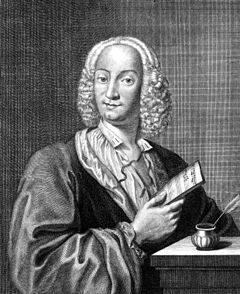Semiramide (RV 733) is a dramma per musica in three acts by Antonio Vivaldi composed to a libretto by Francesco Silvani.[1]
| Semiramide | |
|---|---|
| Dramma per musica by Antonio Vivaldi | |
 Portrait of Vivaldi, 1725 | |
| Librettist | Francesco Silvani |
| Language | Italian |
| Premiere | 26 December 1731 Archducal theatre in Mantua |
It was his ultimate work at the archducal theatre in Mantua, where Vivaldi was maestro di cappella from 1718 until 1720. The production started the young castrato Mariano Nicolini in the role of Oronte as well as the famous "prima donna" Anna Girò in the role of Semiramide, with Maria Maddalena Pieri, famous for her breeches roles, as Nino.[2][3] It was first performed on 26 December 1731[4] for the 1732 carnival season.[5][6] Only the libretto and individual arias have survived.[7]
The story of Semiramis was the subject of plays by Crébillon, Voltaire and Calderon de la Barca as well as of other operas by Porpora, Gluck, Rossini and dozens of other composers.[8][9][10][11]
References
edit- ^ Reinhard Strohm (2008). The Operas of Antonio Vivaldi. L.S. Olschki. p. 507. ISBN 978-88-222-5682-9.
- ^ "Maria Maddalena Pieri". quellusignolo.fr. Quell'usignolo. Retrieved 16 February 2020.
- ^ Sylvie Mamy (8 June 2011). Antonio Vivaldi. Fayard. p. 277. ISBN 978-2-213-66579-5.
- ^ Casaglia, Gherardo (2005). "Semiramide, 26 December 1731". L'Almanacco di Gherardo Casaglia (in Italian).
- ^ Leone Allacci; Giovanni Cendoni; Apostolo Zeno (1755). Drammaturgia di Lione Allacci: accresciuta e continuata fino all'anno MDCCLV. Presso G. Pasquali. p. 708 – via Internet Archive.
- ^ Félix Clément; Pierre Larousse (1999). Dictionnaire lyrique ou Histoire des opéras. Slatkine. p. 615. ISBN 978-2-05-101696-4.
- ^ "Semiramide". klassica.info. Klassika. Retrieved 16 February 2020.
- ^ Frassoni, Edilio (1980). "Imperatrice di molte favelle". In Ufficio Stampa dell'E.A. (ed.). L'Opera di Genova. Stagione Lirica 1980–81. Teatro Margherita (in Italian). E.A. Teatro Comunale dell'Opera di Genova. p. 101: "Il lungo cammino di Semiramide nel melodramma". Professor Frassoni lists 77 settings of the story of Semiramis, from Antonio Cesti’s La Semirami (Vienna, 1662), to Costantino Dall’Argine’s ballet La Semiramide del Nord (Milan, La Scala, 1869). To be precise, the list also contains 5 pasticcios. 3 ballets and 6 works by unknown authors, but does not include subsequent revisions and rewrites by the same composer. It does not claim to be exhaustive: for instance, just referring to the 20th century, Ottorino Respighi’s tragic poem Semirâma (Bologna, 1910) and Arthur Honegger’s ballet-melodrama Sémiramis (Paris, 1934), are not included.
- ^ Robinson, Michael F. (11 July 2012) [1 December 1992]. "Semiramide riconosciuta (dramma per musica by Porpora) (Semiramis Recognized)". Grove Music Online (8th ed.). Oxford University Press. ISBN 978-1-56159-263-0.
- ^ Jean Bottéro (1994). L'Oriente antico. Dai sumeri alla Bibbia. Edizioni Dedalo. p. 169. ISBN 978-88-220-0535-9.
- ^ George Jellinek (1994). History Through the Opera Glass: From the Rise of Caesar to the Fall of Napoleon. Pro/Am Music Resources. p. 340. ISBN 978-0-912483-90-0.